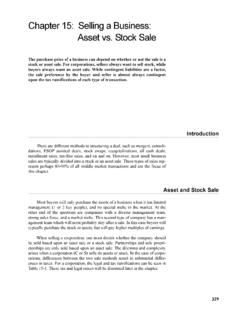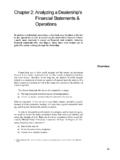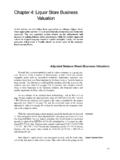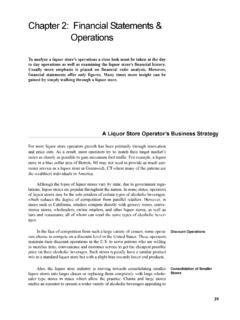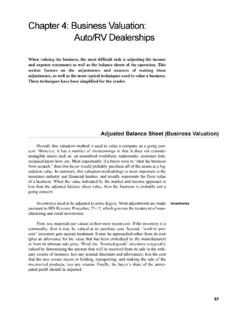Transcription of Chapter 11: Fractional Interests (Real Estate)
1 Chapter 11: Fractional Interests ( real estate ). real estate discounts are radically different from those adjustments for minority Interests for privately held equity adjustments. The most important difference is the ability to force liquidation by owners of Fractional Interests in real estate . These adjustments are most associated with Fractional Interests in a land parcel or building. The main reason for the discount adjustment is the sharing of control. Introduction Most individuals simply assume that minority Interests or Fractional inter- ests in real estate are identical or similar to partial Interests in privately held businesses.
2 The application of discounts for minority interest and marketability studies for privately held firms is not transferable to real estate . A 100% undivided interest in real property can, in some ways, be com- pared to a 100% interest in the stockholders' equity of a company. A 100% own- ership interest in a company will influence, among other things: the strategic direction that the company takes the election of officers and directors the disposition of assets the company's pricing or dividend policy In the case of real property, a 100% undivided interest enables the owner to assume active management of the property or select the property management company; develop and/or sell the property; determine the amount of income dis- tribution, if any.
3 And dictate leasing terms, and so on. Discount adjustments are usually applied by buyers for ownership Interests which have concurrent ownership with another person. There are four basic types of concurrent ownership: (1) tenancy in common (2) joint tenancy (3) community property (4) tenancy in partnership 251. Fractional Interests ( real estate ). These different Interests are summarized in Table 11-1. Table 11-1: Summary of Typical Types of real estate Concurrent Ownership Tenancy in Characteristics Tenancy in common Joint tenancy Community property partnership Definition An interest held by two Where two or more per- All property acquired Two or more persons or more persons, each sons are joint and equal by husband and wife own property for having a possessory owners of the same undi- during marriage.
4 Partnership purposes. right in the same piece vided interest in real or of property. personal property. Right of survivorship No Yes Yes Depends upon agree- ment % Interests Any fraction Any fraction 50:50 Any fraction Pros Can easily force liqui- Survivor holds property Each spouse has right to Can easily force liq- dation by appealing to free from debts of dispose of his or her 1/2 uidation by appealing court. deceased tenant and from interest by will. to court. liens from tenant's inter- est. Cons Shared ownership Decedent may not want Neither may make a gift Shared ownership surviving joint tenant to without the consent of get title free and clear; the other; failure to dis- cannot give up interest by pose of spouse's 1/2.
5 Will; possible negative tax interest by will allows ramifications. surviving spouse title free and clear. Before beginning a valuation assignment, it is important to know whether the interest being valued has a right of survivorship, meaning that if one joint tenant dies, the surviving joint tenant (or tenants) immediately becomes the sole owner. In general, if there is no right of survivorship, then some discount may be warranted. For a right of survivorship, a discount from the par value is ques- tionable.
6 Most discounts focus upon tenancies in common, due to there being no right of survivorship. As a result, the rest of this Chapter will focus upon tenan- cies in common. Liquidity When parties hold property as co-tenants, each has an unrestricted right to possession and use of the property, so long as he or she does not exclude, or oust, the others. Irreconcilable disagreements among the parties can be solved by: (1) partitioning the parcel by dividing it into separate properties, each of which is held in fee by only one of the former co-tenants; or (2) by selling it and dividing the proceeds; or gifting the interest .
7 Partition First, if the property can be partitioned, then the land parcel or building will be sub-divided. If this cannot be done, or is infeasible, then there is a sec- ond solution. 252. Fractional Interests ( real estate ). The second solution is that each owner of a tenancy in common may sell Forced Liquidation his or her interest , transfer or will his or her interest separately from the other owners. The recipient of the interest then takes the place of the prior tenant and the tenancy in common continues as before.
8 If the owners of the property are unable to agree among themselves as to the management of the property, then any one of them may apply to the Court for an order that the property be sold and that any profits from the sale be divided in the same proportion as each per- son's ownership interest in the tenancy. For example, it takes between 12-18. months in California to have a court liquidate the holdings of the tenants in common. An important difference between a partnership or business entity minority 1% & 99% Interests Have interest and a Fractional interest in real estate is the difference of power to force Equal Control liquidation.
9 For example, in most states a 1% interest in a piece of real estate carries the same rights as a 99% interest holder. If the owner of the 1% interest is not satisfied, then he or she can force liquidation. This is not true for a 1%. interest holding in a limited partnership, general partnership, or corporation. Both of the two alternatives discussed above may be costly and involve delays. Also, the risk that they will eventually become necessary often seems great, particularly when the co-tenants are unrelated.
10 For these reasons, undi- vided Interests are valued with an adjusted discount below their pro rata share of the fair market value of the overall Obviously a buyer who seeks control and 100% ownership of the real estate would pay a market price for the real property. On the other hand, a potential buyer of a Fractional interest would discount his or her purchase price from the par value in order to account for the shared control with the other frac- tional interest owners of a property. The rationale is that the buyer would want a higher or enhanced yield on his money in order to compensate him for the addi- tional risk and lack of liquidity of the investment.

